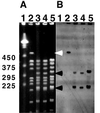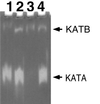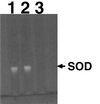Targeted mutagenesis by duplication insertion in the radioresistant bacterium Deinococcus radiodurans: radiation sensitivities of catalase (katA) and superoxide dismutase (sodA) mutants
- PMID: 9882685
- PMCID: PMC93425
- DOI: 10.1128/JB.181.2.666-669.1999
Targeted mutagenesis by duplication insertion in the radioresistant bacterium Deinococcus radiodurans: radiation sensitivities of catalase (katA) and superoxide dismutase (sodA) mutants
Abstract
Deinococcus radiodurans R1 is extremely resistant to both oxidative stress and ionizing radiation. A simple and general targeted mutagenesis method was developed to generate catalase (katA) and superoxide dismutase (sodA) mutants. Both mutants were shown to be more sensitive to ionizing radiation than the wild type.
Figures




Similar articles
-
[Catalase and superoxide dismutase activity in isogenous bacterial strains with different degrees of radioresistance].Nauchnye Doki Vyss Shkoly Biol Nauki. 1984;(9):30-3. Nauchnye Doki Vyss Shkoly Biol Nauki. 1984. PMID: 6388648 Russian.
-
Recombination between a resident plasmid and the chromosome following irradiation of the radioresistant bacterium Deinococcus radiodurans.Gene. 1997 Mar 18;187(2):225-9. doi: 10.1016/s0378-1119(96)00755-x. Gene. 1997. PMID: 9099885
-
On the mechanism of oxygen protection against ionizing radiation damage in the cell wall of Micrococcus radiodurans.Radiat Res. 1979 Jul;79(1):63-76. Radiat Res. 1979. PMID: 472126 No abstract available.
-
A model for repair of radiation-induced DNA double-strand breaks in the extreme radiophile Deinococcus radiodurans.Bioessays. 1995 May;17(5):457-64. doi: 10.1002/bies.950170514. Bioessays. 1995. PMID: 7786292 Review.
-
[Superoxide dismutase--radiobiologic significance and possibilities (review)].Vopr Med Khim. 1980 May-Jun;26(3):291-301. Vopr Med Khim. 1980. PMID: 7006203 Review. Russian.
Cited by
-
Purification, crystallization and phase determination of the DR1998 haem b catalase from Deinococcus radiodurans.Acta Crystallogr F Struct Biol Commun. 2014 May;70(Pt 5):659-62. doi: 10.1107/S2053230X1400764X. Epub 2014 Apr 25. Acta Crystallogr F Struct Biol Commun. 2014. PMID: 24817732 Free PMC article.
-
In situ determination of manganese(II) speciation in Deinococcus radiodurans by high magnetic field EPR: detection of high levels of Mn(II) bound to proteins.J Biol Chem. 2013 Feb 15;288(7):5050-5. doi: 10.1074/jbc.C112.444992. Epub 2013 Jan 9. J Biol Chem. 2013. PMID: 23303180 Free PMC article.
-
Global analysis of the Deinococcus radiodurans proteome by using accurate mass tags.Proc Natl Acad Sci U S A. 2002 Aug 20;99(17):11049-54. doi: 10.1073/pnas.172170199. Epub 2002 Aug 12. Proc Natl Acad Sci U S A. 2002. PMID: 12177431 Free PMC article.
-
Untargeted metabolite profiling reveals that nitric oxide bioynthesis is an endogenous modulator of carotenoid biosynthesis in Deinococcus radiodurans and is required for extreme ionizing radiation resistance.Arch Biochem Biophys. 2016 Jan 1;589:38-52. doi: 10.1016/j.abb.2015.10.010. Epub 2015 Nov 10. Arch Biochem Biophys. 2016. PMID: 26550929 Free PMC article.
-
Effects of intracellular Mn on the radiation resistance of the halophilic archaeon Halobacterium salinarum.Extremophiles. 2013 May;17(3):485-97. doi: 10.1007/s00792-013-0533-9. Epub 2013 Mar 27. Extremophiles. 2013. PMID: 23532412
References
-
- Bauer A W, Kirby W M, Sherris J C, Turck M. Antibiotic susceptibility testing by a standardized single disk method. Am J Clin Patrol. 1966;45:493–496. - PubMed
-
- Beauchamp C, Fridovich I. Superoxide dismutase: improved assays and an assay applicable to acrylamide gels. Anal Biochem. 1971;44:276–287. - PubMed
-
- Bradford M M. A rapid and sensitive method for the quantification of microgram quantities of protein utilizing the principle of protein-dye binding. Anal Biochem. 1976;72:248–254. - PubMed
-
- Carbonneau M A, Melin A M, Perromat A, Clerc M. The action of free radicals on Deinococcus radiodurans carotenoids. Arch Biochem Biophys. 1989;275:244–251. - PubMed
Publication types
MeSH terms
Substances
LinkOut - more resources
Full Text Sources
Other Literature Sources
Molecular Biology Databases

